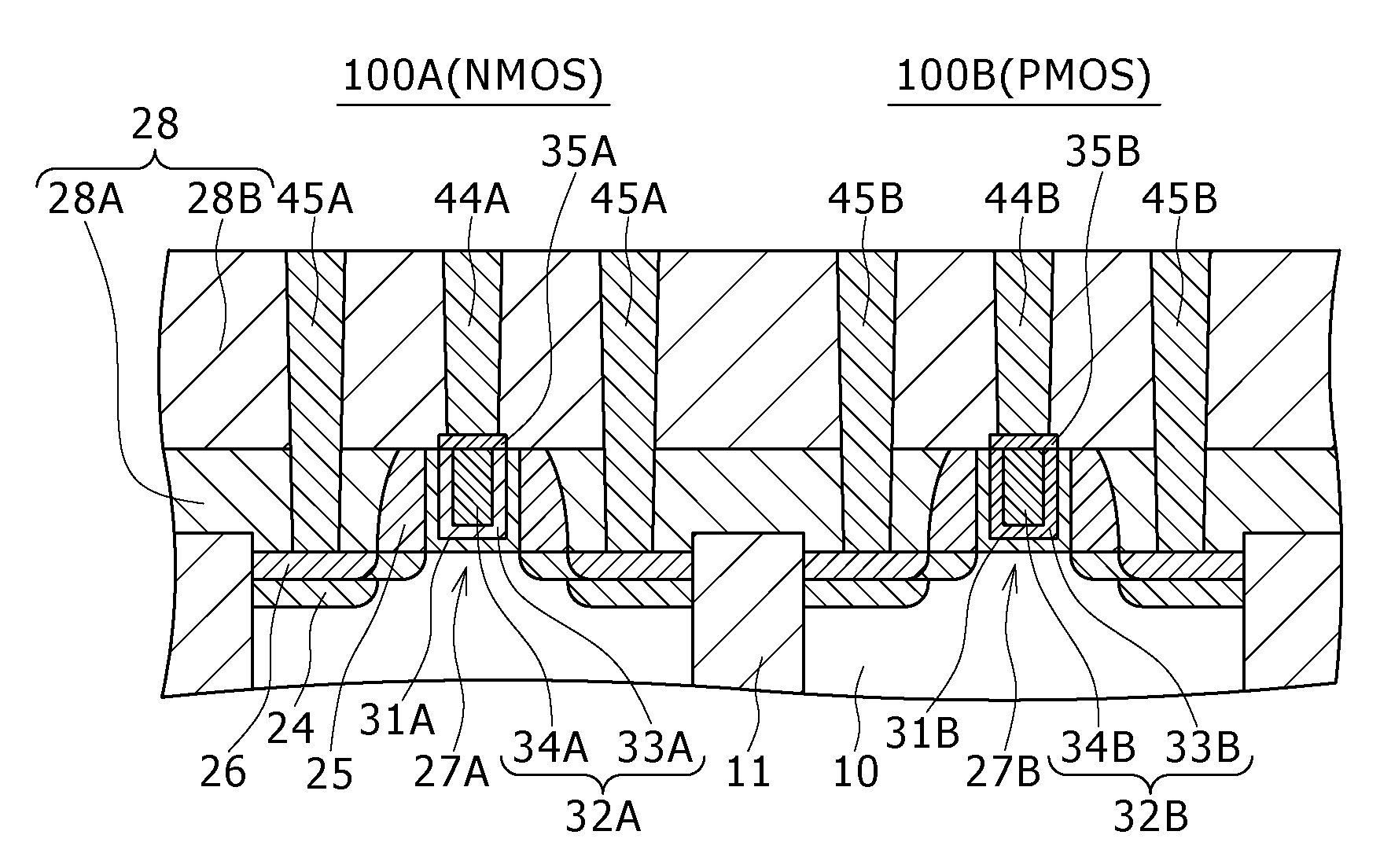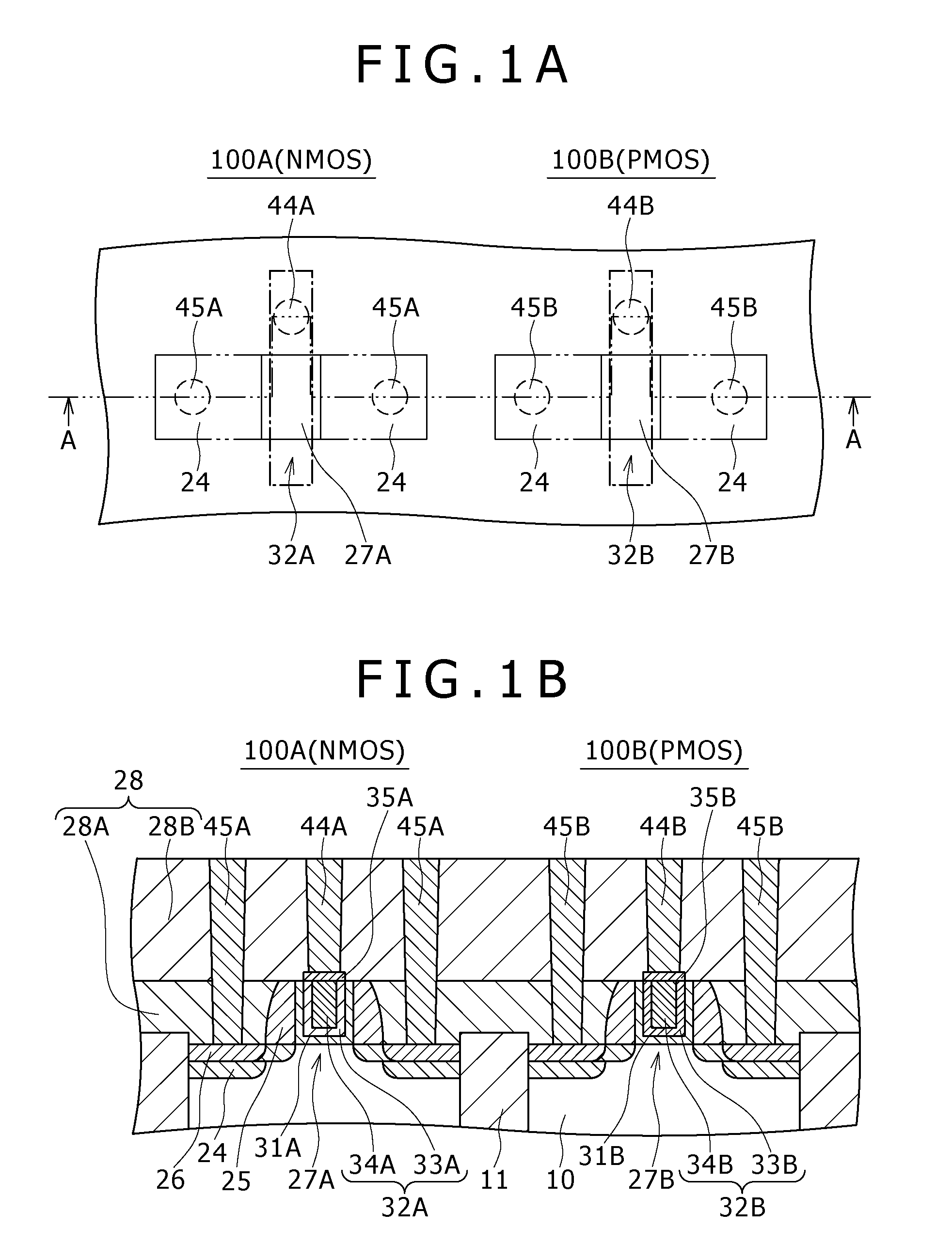Semiconductor device and method for manufacturing same
a semiconductor device and semiconductor technology, applied in the direction of semiconductor devices, electrical devices, transistors, etc., can solve the problems of difficult to satisfy all, problematically deteriorating planarity of the top surface of the gate electrode, etc., to improve the characteristics of the semiconductor device, improve the flexibility of selection of conductive materials, and optimize the manufacturing process
- Summary
- Abstract
- Description
- Claims
- Application Information
AI Technical Summary
Benefits of technology
Problems solved by technology
Method used
Image
Examples
first embodiment
[0075]A first embodiment of the present invention relates to a semiconductor device and a method for manufacturing the same according to the first embodiment of the present invention. Insulated gate field effect transistors included in the semiconductor device of the first embodiment are MOSFETs. Furthermore, the semiconductor device of the first embodiment includes an NMOS and PMOS. This is the same also in other embodiments to be described later.
[0076]FIG. 1A schematically shows a projected image of an NMOS 100A and a PMOS 100B included in the semiconductor device of the first embodiment. In FIG. 1(A), the dashed line represents various kinds of contact plugs, the one-dot chain line represents gate electrodes, and the two-dot chain line represents source / drain regions and channel forming regions. FIG. 1B is a partial sectional view along the three-dot chain line indicated by arrowheads A in FIG. 1A.
[0077]The semiconductor device of the first embodiment includes the NMOS 100A as an...
second embodiment
[0105]A second embodiment of the present invention is a modification of the first embodiment. A projected image of an NMOS 200A and a PMOS 200B included in a semiconductor device of the second embodiment is the same as that of FIG. 1A. FIG. 3 is a partial sectional view of the semiconductor device of the second embodiment, equivalent to the partial sectional view along the three-dot chain line indicated by arrowheads A in FIG. 1A. Components of the NMOS 200A and the PMOS 200B are basically the same as those in the first embodiment, and hence are given the same reference numerals as those in the first embodiment. This is the same also in other embodiments to be described later.
[0106]The second embodiment is different from the first embodiment in that a gate electrode 32A of the NMOS 200A has a multilayer structure formed of conductive material layers 33A, 33B, and 34A. With reference to FIGS. 4A to 4C, a method for manufacturing the semiconductor device of the second embodiment will ...
third embodiment
[0115]A third embodiment of the present invention is also a modification of the first embodiment. A projected image of an NMOS 300A and a PMOS 300B included in a semiconductor device of the third embodiment is the same as that of FIG. 1A. FIG. 5 is a partial sectional view of the semiconductor device of the third embodiment, equivalent to the partial sectional view along the three-dot chain line indicated by arrowheads A in FIG. 1A.
[0116]The third embodiment is different from the first embodiment mainly in that formation of a third conductive material layer 34 is omitted. With reference to FIGS. 6A and 6B, a method for manufacturing the semiconductor device of the third embodiment will be described below.
[Step-300]
[0117]Initially, based on steps similar to [Step-100] and [Step-110] of the first embodiment, a semiconductor substrate 10 (base) is obtained that is composed of silicon (Si) and includes channel forming regions 27A and 27B of the NMOS 300A and the PMOS 300B, source / drain ...
PUM
 Login to View More
Login to View More Abstract
Description
Claims
Application Information
 Login to View More
Login to View More - R&D
- Intellectual Property
- Life Sciences
- Materials
- Tech Scout
- Unparalleled Data Quality
- Higher Quality Content
- 60% Fewer Hallucinations
Browse by: Latest US Patents, China's latest patents, Technical Efficacy Thesaurus, Application Domain, Technology Topic, Popular Technical Reports.
© 2025 PatSnap. All rights reserved.Legal|Privacy policy|Modern Slavery Act Transparency Statement|Sitemap|About US| Contact US: help@patsnap.com



